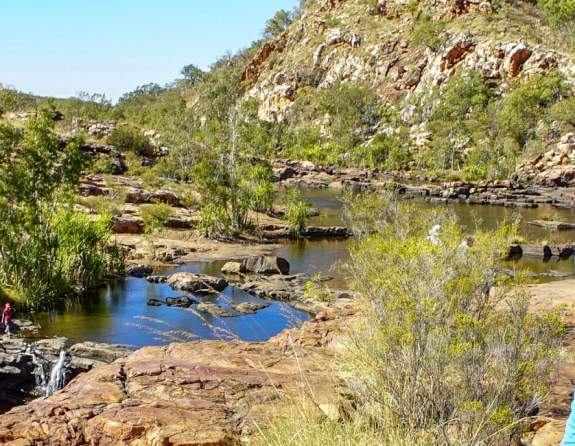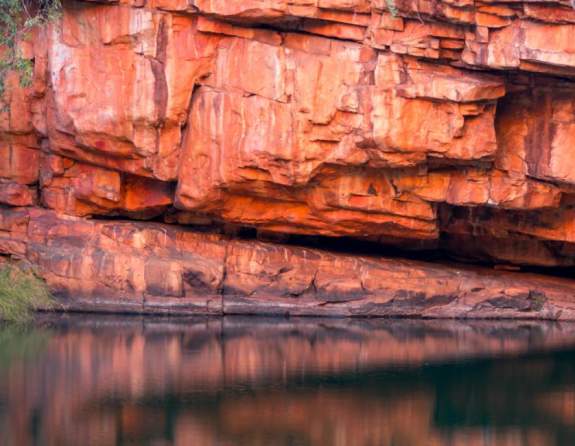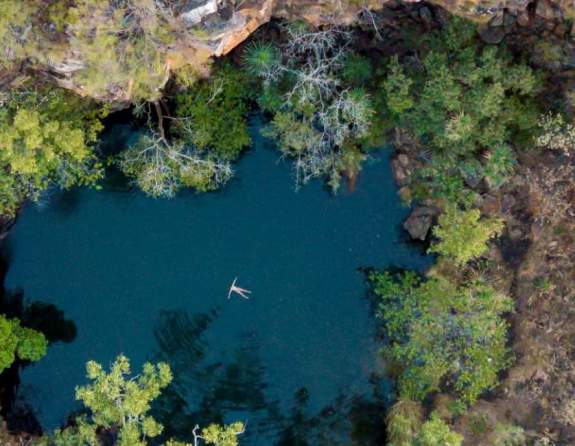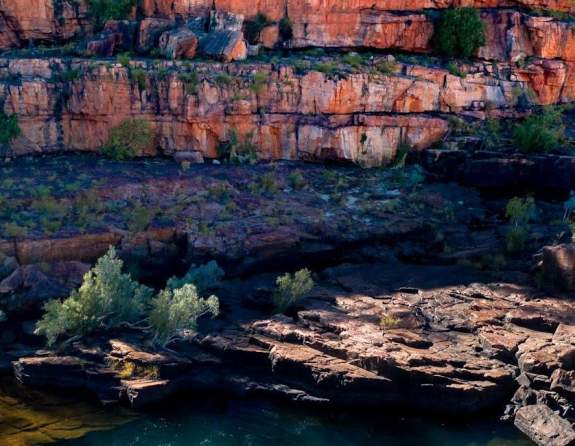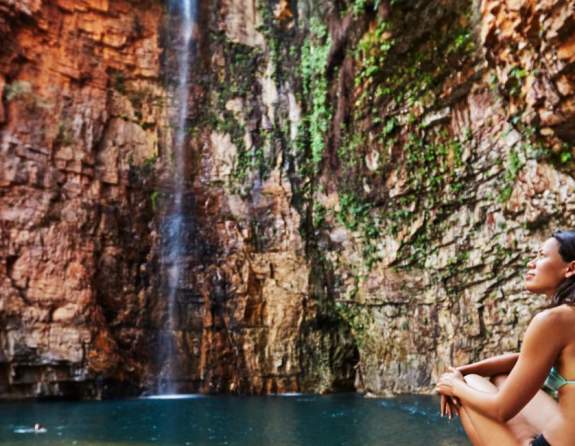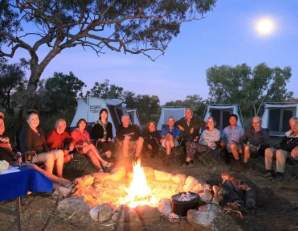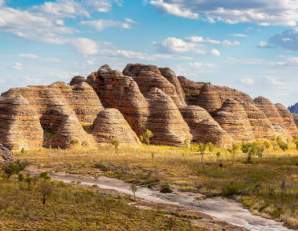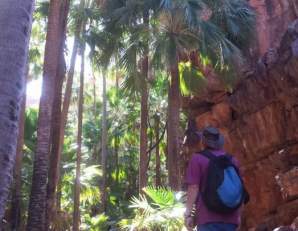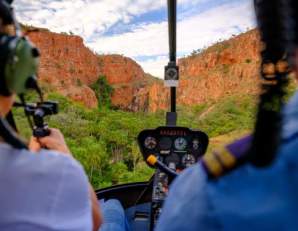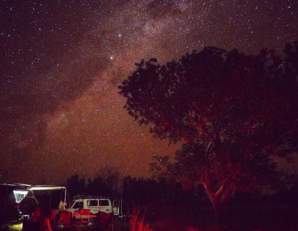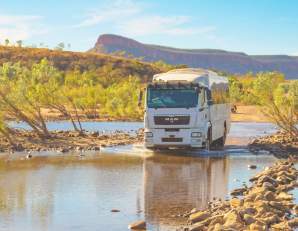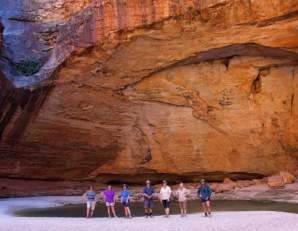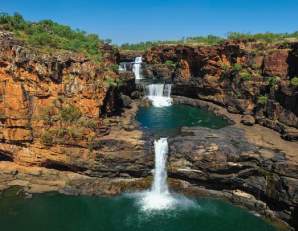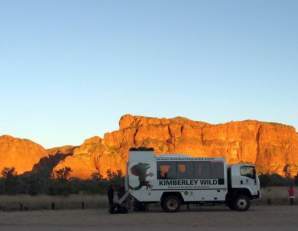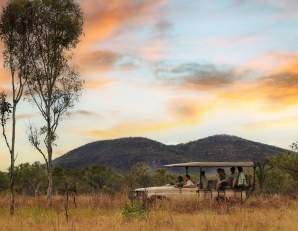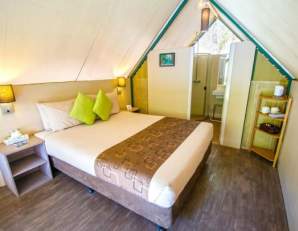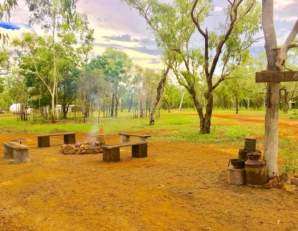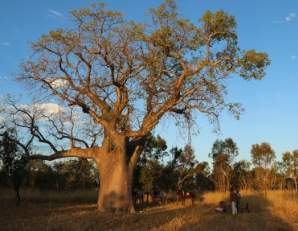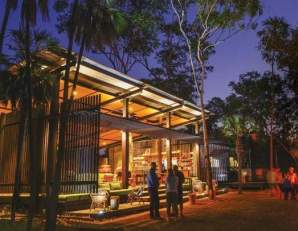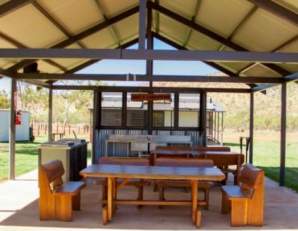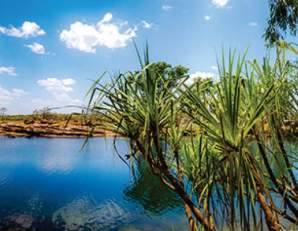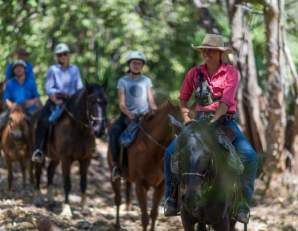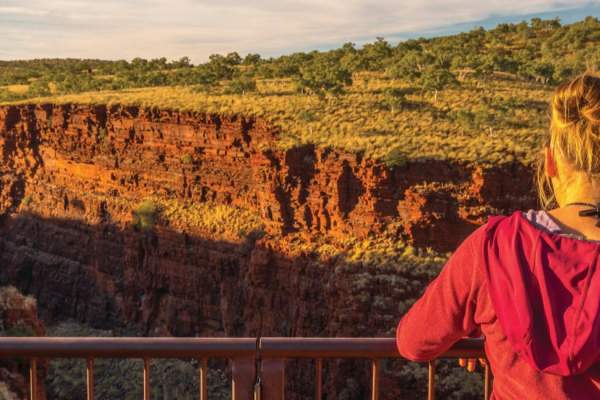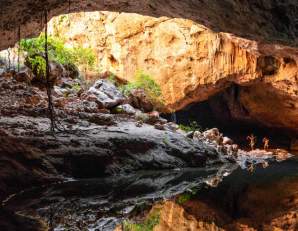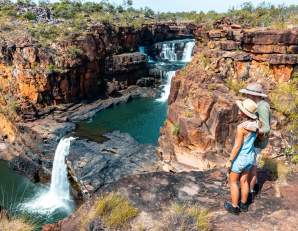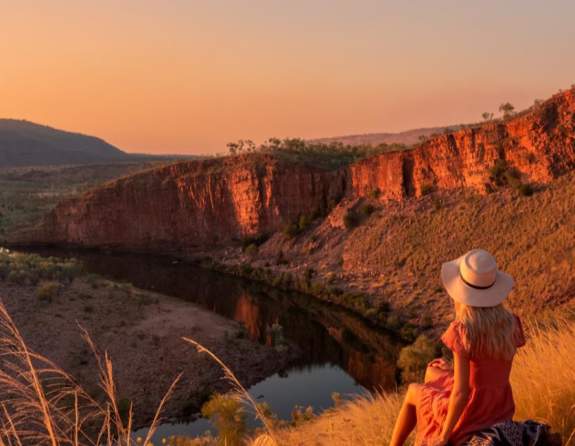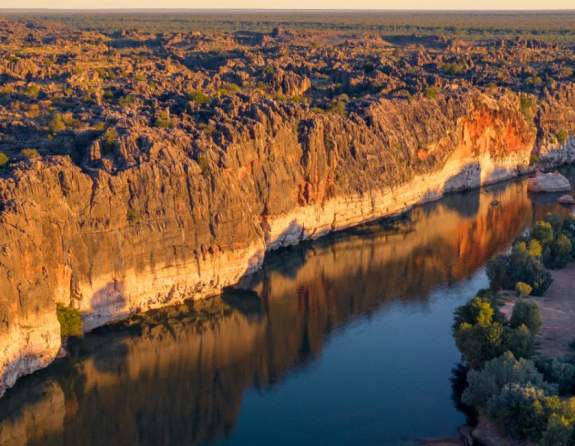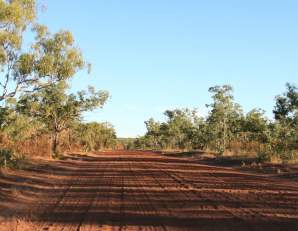Gibb River Road
A true outback odyssey on one of Australia’s most unique 4WD tracks.
Turning off the bitumen and going ‘over the range’ on the Gibb River Road is a truly unique Aussie outback adventure through the Kimberley’s vast untouched wilderness, ancient gorge country and epic cattle stations the size of small countries.
Originally constructed in the 1960s to transport cattle from outlying stations to the ports of Derby and Wyndham, the 660-kilometre 4WD trail is the best way to discover the natural treasures of the Kimberley’s wild heartlands.
- Gorges
- Gibb River Road Tours
- Places to Stay
- Itineraries
- Plan Your Trip
- About the Gibb River Road
- Continue Your Journey
- Frequently Asked Questions
Read on to plan your trip, including details of the Gibb’s gorges, accommodation and camping along the way, tours, suggested itineraries and the practical details like maps, driving distances and fuel stops.
Explore the Gorges
The river gorges, cascading waterfalls and freshwater swimming holes along the Gibb are some of natures best, and a welcome reward after walking the bush tracks to get to them.
While walking the trails and exploring the waterfalls, keep an eye out for Aboriginal rock art sites under ledges and overhangs. These are important cultural sites, so please do not touch or disturb them.
Sun-bleached rocks wind through a bush landscape which leads you to the first water filled pool. The backdrop of an amber hued hill reveals a dreamy, reflective…
Adcock Gorge is a picturesque gorge and swimming spot on Mt House station, approximately 5 kilometres off the Gibb River Road. The driving track is 4WD only.
Galvan’s Gorge is the most accessible gorge along the Gibb, located just 1 kilometre off the road. This is a popular and pretty swimming spot, with a small…
Located on Manning Creek in the grounds of the 283,280ha Mt Barnett Station, water remains at the base of the waterfalls and in several pools along the creek year…
The serene surroundings of Emma Gorge waterfall make it a tranquil and relaxing place to swim. An approximate one-hour picturesque walk over rocky terrain rewards…
Tours that take you along the Gibb
Head off the beaten track with an experienced guide and like-minded fellow travellers, join a micro-group (6 travellers or fewer) or to take a private charter/tour.
Gibb River Road tours allow for a choice of accommodation, from fully accommodated, to participatory camping tours, where you pitch in to set up camp and prepare the evening meal, tours offering permanent campsites for some or all of your overnight stays, or tours allowing you to choose to upgrade your accommodation along the way.
The classic Kimberley 4WD itineraries can vary from 10 to 15 days, travelling through the Gibb River Road and onwards to take in all of the region's major attractions, such as the Purnululu National Park (the Bungles), and on some longer itineraries, the Punamii-Unpuu (Mitchell Falls).
Adventure Wild Kimberley Tours
Adventure Wild Kimberley Tours provide quality, all-inclusive safaris of the spectacular…
WA NT TOURS
The West Coast is our home! WA NT TOURS are the specialists for guided small group tours…
Kimberley Safari Tours
Put on your hiking shoes, have your swimming gear handy and get ready for breathtaking…
El Questro Tours & Activities
Spend some time exploring the magical landscapes of El Questro - join a guided walking, 4WD or…
Kimberley Dreaming
Kimberley Dreaming is a small, independent and local tour business, located in Kununurra in…
On the Verandah
Join an On The Verandah Kimberley workshop and experience life on a remote cattle…
Inspiration Outdoors
Explore the North West with Inspiration Outdoors Western Australia's North West is a land of…
Kimberley Outback Tours
Kimberley Outback Tours operate multi-day tours throughout Western Australia and the Northern…
Venture North Safaris
Venture North is a multi-award winning, family owned company specialising in micro-group…
APT Kimberley Wilderness Adventures
Explore the Kimberley with the experts, with over 45 years experience and every detail taken…
Kimberley Wild Expeditions
Kimberley Wild Expeditions offer the best value tours in Western Australia. Family-owned and…
Kimberley Spirit Tours
Explore Western Australia’s spectacular Kimberley region with Kimberley Spirit tours. Discover…
Where to stay on the Gibb River Road
There's a surprising range of accommodation for travellers along the Gibb River Road, from campsites to station stays and glamping.
APT Bell Gorge Wilderness Lodge
Close to some of the Kimberley’s most beautiful gorges, APT’s Bell Gorge Wilderness Lodge is…
Mount Hart Wilderness Lodge
Nestled in a hidden oasis along the famous Gibb River Road, Mount Hart Wilderness Lodge is a…
El Questro - Emma Gorge Resort
El Questro Emma Gorge is a hidden treasure at the base of the fiery red cliffs of the Cockburn…
Mt Elizabeth Station Stay
Mt Elizabeth Station is about as close to the heart of the Kimberley region in Western…
Silent Grove Campground
The campground at Silent Grove is a great base from which to explore Bell Gorge, including its…
El Questro - The Homestead
The luxurious El Questro Homestead sits in an exclusive oasis in Western Australia's rugged…
Birdwood Downs Station
Birdwood Downs Station is a pastoral station of 2500 ha located on the Gibb River Road in the…
APT Mitchell Falls Wilderness Lodge
The Mitchell Falls Wilderness Lodge is a stunning example of APT’s 'touch of luxury in the…
Imintji Campground
The Imintji (Ngarinyin) people invite you to stay at this sheltered location at the foot of…
Munurru (King Edward River) Campground
The first campground visitors come across when they approach Mitchell Falls. It makes a…
Explore Gorges in Stations and Wilderness Camps
Dotted along the Gibb a number of former and current cattle stations offer camping, comfortable accommodation and meals, as well as the chance to discover some of the gorges and sights tucked away in millions of acres of remote and spectacular country.
Allow at least an overnight stay at the stations and wilderness camps to give yourself enough time to explore.
El Questro - The Station
El Questro sprawls over 700,000 acres and is one of the world's most unique holiday…
Mount Hart Wilderness Lodge
Nestled in a hidden oasis along the famous Gibb River Road, Mount Hart Wilderness Lodge is a…
Mt Elizabeth Station Stay
Mt Elizabeth Station is about as close to the heart of the Kimberley region in Western…
National Parks along the Gibb
Many of the North West’s incredible natural attractions are located in the spectacular surroundings of our National Parks.
Wunaamin Miliwundi Ranges Conservation Park
Situated on the south-western edge of the Kimberley Plateau along the Gibb River Road, explore…
Dimalurru (Tunnel Creek) National Park
Dimalurru (Tunnel Creek) National Park is Western Australia's oldest cave system. You…
Mitchell Falls & The Mitchell River National Park
The four-tiered Mitchell Falls is an iconic Kimberley attraction, and one of the most…
Bandilngan (Windjana Gorge) National Park
Carved by the Lennard River, Bandilngan (Windjana Gorge) is over three kilometres long with…
Gibb River Road Itineraries
Whether you're planning to explore every part of the Gibb on a longer trip, or seeing the highlights on a shorter one, you'll find plenty to delight you in the Gibb's gorges, stations and landscapes.
Allow yourself at least 14 days to truly immerse yourself in the adventure at Windjana Gorge, Tunnel Creek, Lennard Gorge, Bell Gorge, Galvans Gorge, Manning Gorge, Drysdale River Station, Balanggarra Home Valley Station and El Questro Wilderness Park. Or make a shortlist of your must-see attractions for a shorter, but no less exciting trip.
Our itineraries will give you lots of inspiration!
Tackle one of Australia's most iconic outback drives, the Gibb River Road, soaking in all that the Kimberley has to offer.
On this self-drive adventure, experience the 350-million-year old Balili (Devonian Reef) system, the vast and panoramic landscape of the Fitzroy River floodplains…
Plan your Gibb River Road Trip
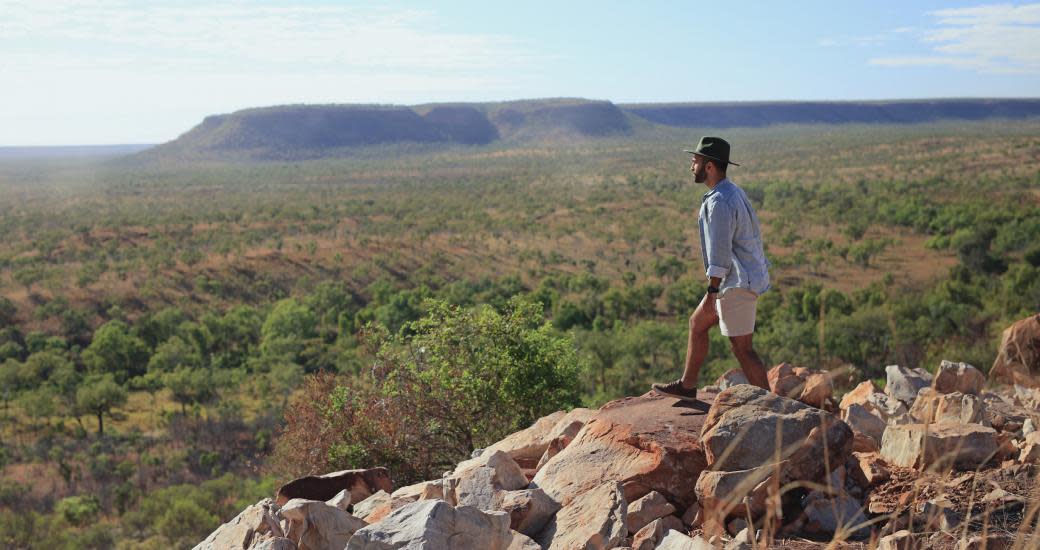
Guides & Maps
When travelling along the Gibb, you'll need a National Parks Pass, or pay entry at Bandilgnan (Windjana Gorge) and Dimalurru (Tunnel Creek) NP's. At El Questro Wilderness Park, Visitor Passes (valid for one or seven days) will give you access to a wilderness wonderland. Travelling further north to Punamii-Unpuu (Mitchell Falls)? You can purchase your Unuguu Visitor Pass online, or at Drysdale River Station. We highly recommend purchasing Derby Visitor Centre's annual Gibb River Road Guide.
Gibb River Road Map
This map of the Gibb River Road, produced by Derby Visitor Centre is a great planning tool for your Gibb River Road trip and part of the Gibb River and Kalumburu Roads Guide. You can pick up the guide in person from Derby or Kununurra Visitor Centres, or you can order a copy by post from from the Derby Visitor Centre here.
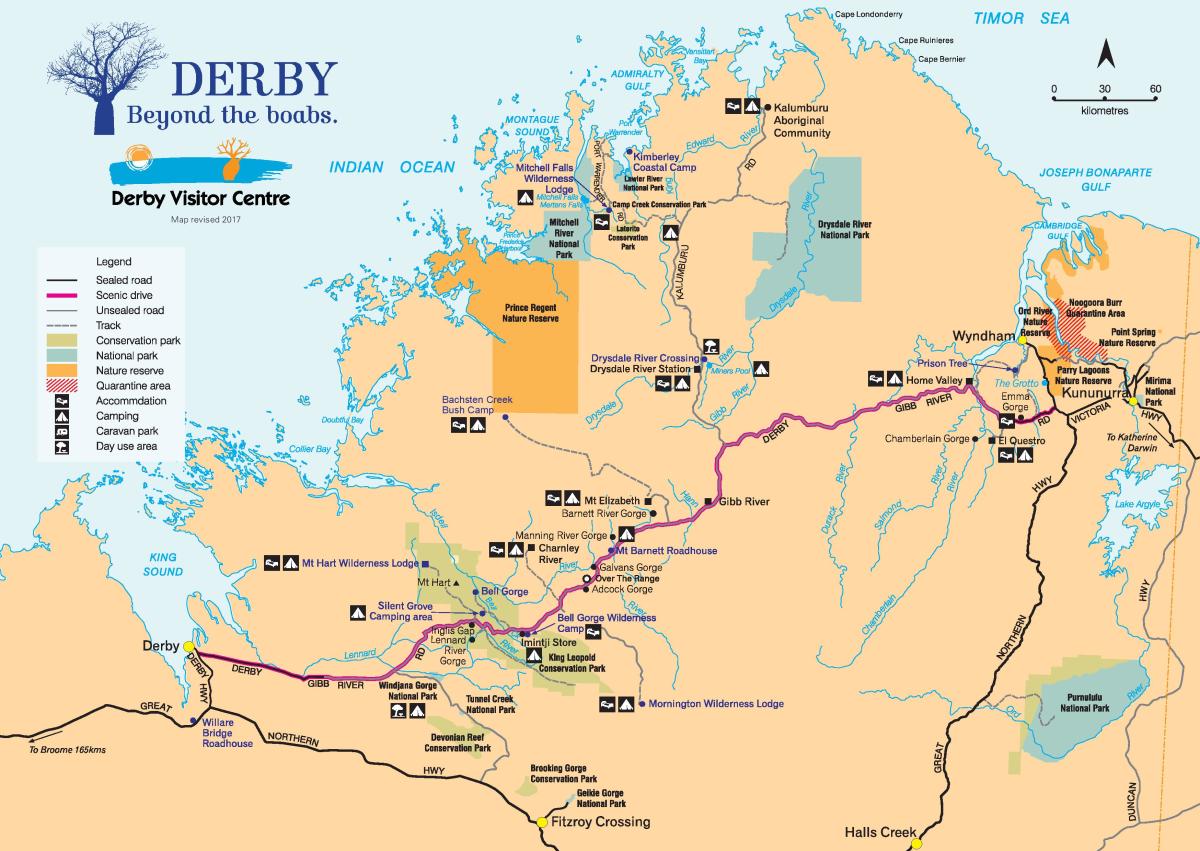
Fuel and Supplies along the Gibb River Road
Fuel and basic supplies are available at a small number of roadhouses and stations along the Gibb River Road. While the distances between fuel stops are manageable, it is important to take into account the extra kilometres travelled along side tracks to tourist sites and accommodation. Travellers are advised to carry jerry cans with extra fuel.
Fuel along the Gibb River Road:
Derby - Imintji Store (Diesel only; mechanical and tyre repair; grocery items) 227km.
Imintji Store – Mt Barnett Roadhouse (Diesel and petrol; grocery items) 80km.
Mt Barnett Roadhouse – El Questro (Diesel and petrol; minor mechanical and tyre repair; grocery items) 320km.
El Questro – Kununurra 81km.
Note: while Balanggarra Home Valley Station does not sell fuel, it does have a workshop for mechanical and tyre repairs. Balanggarra Home Valley Station is closed in 2022.
Fuel along the Kalumburu Road/Mitchell Plateau
Drysdale River Station (Diesel and petrol; tyre repairs; grocery items).
Prepare before you go:
Broome, Derby and Kununurra all have well-stocked supermarkets where you can stock up for your trip. Local butchers Tenderspot in Broome and Kununurra, and Sampey Meats in Derby can cryovac meat packs for you; we recommend that you place an order for these packs well in advance of your trip.
About the Gibb River Road
The route of the Gibb River Road crosses the traditional lands of many Kimberley peoples, including the Njikena, Bunuba, Ongkomi, Ngarinyin, Gedija, Worrorra and Wunumbal language groups. A rich indigenous culture has been practised throughout the area for many thousands of years, and the Gwion (Bradshaw) and Wandjina rock art traditions are features of the rock paintings in the region surrounding the Gibb River Road and Mitchell Plateau.
Once pastoralists moved across the Kimberley and established cattle stations, Aboriginal people were forcibly displaced from their traditional lands, working as stockmen and domestics on stations, and living and working in remote missions.
While the Gibb River Road as we know it today was constructed in the 1960’s, pastoralists had previously constructed two unsealed tracks linking Derby with Mt House station in the west, and Wyndham with Karunjie Station, Gibb River Station and Kalumburu in the east. Both tracks (known as the Mt House Road and Karunjie Track) were hand-hewn roadways wide enough for bullock wagons, and for drovers with their cattle herds.
These roads provided essential connections between the ports at Derby and Wyndham and outlying stations, but the going was rough – it could take over a week to travel with a supply wagon from Mt House to Derby.
The “Beef Roads Programme” was set up by the government in 1949 to provide funding for the construction of infrastructure to support the beef industry. The Gibb River Road was constructed as part of this programme, and under the supervision of Main Roads WA teams of surveyors, engineers and labourers set out on an arduous 3-year road-building project.
The Gibb River Road only partially follows the routes of the Mt House Road and Karunjie Track – with the benefit of explosives and heavy machinery, the road team were able to cut a new direct route through the Napier and Wunaamin Miliwundi Ranges, and construct creek crossings. The first beef truck travelled the western section of the road in 1963, while works continued at the eastern end until 1967, completing the route of the Gibb River Road that we travel today.
In the 1980’s and 1990’s Aboriginal communities were established along the Gibb River Road, including Imintji, Kupingarri (Mt Barnett Station), Ngallagunda (Gibb River Station), Dodonun (east of Mt Elizabeth Station), Prap Prap (west of Doongan Station) and Kandiwal Community at the Mitchell Plateau.
Some of these communities are now involved in the tourism industry along the Gibb River Road and its surrounds, including operating tours, campsites, shops and roadhouses, and galleries featuring local artists.
Derby
Home of Australia’s largest tides, Derby is a friendly and historic outback town perched…
Mitchell Plateau
Venture off the Gibb River Road on a detour that rewards you with jaw-dropping views of the…
Kununurra
The vast, stunning landscapes, remarkable waterways and lush farmland around Kununurra are…
Wyndham
At the end of the Great Northern Highway you will find the little town of Wyndham, which has…
When was the Gibb River Road constructed?
While the Gibb River Road as we know it today was constructed in the 1960’s, pastoralists had previously constructed two unsealed tracks linking Derby with Mt House station in the west, and Wyndham with Karunjie Station, Gibb River Station and Kalumburu in the east. Both tracks (known as the Mt House Road and Karunjie Track) were hand hewn roadways wide enough for bullock wagons, and for drovers with their cattle herds.
Why was the Gibb River road constructed?
The Gibb River Road was constructed as part of the “Beef Roads Programme” which was set up by the government in 1949 to provide funding for the construction of infrastructure to support the beef industry. This programme, and under the supervision of Main Roads WA teams of surveyors, engineers and labourers, set out on an arduous 3 year road-building project.
How long is the Gibb River Road?
The Gibb River Road is 660km in length, between Derby and Kununurra. The majority of the road is gravel and the condition is dependent upon the previous wet season, traffic and the last time a grader repaired it. To really do it justice, allow yourself at least two weeks to have the best experience.
What is the best time of the year to do the Gibb River Road?
Between the months of May and October is considered peak tourist season meaning that most tourist operators and services are fully operational.
Do you need a 4WD to do the Gibb River Road?
A four-wheel drive is required to tackle the Gibb River Road, but for the majority of the time not for the reasons you'd expect. Tracks can become highly corrugated and testing of a vehicle's basic faculties along the Gibb River Road, making a true four-wheel drive the logical choice.
Does your car need a snorkel to do the Gibb River Road?
You won’t need a snorkel for river crossings on the Gibb River Road that time of year, but if it’s very dry your air filter would not get quite as dusty if you had one.



